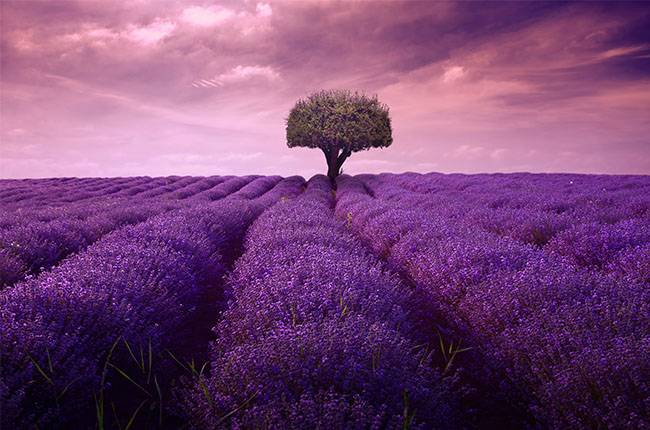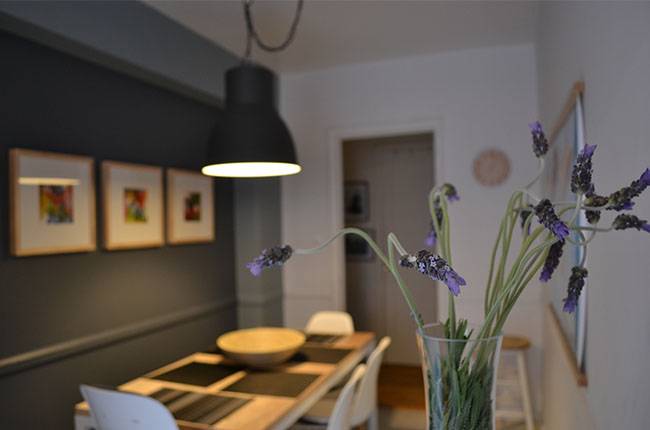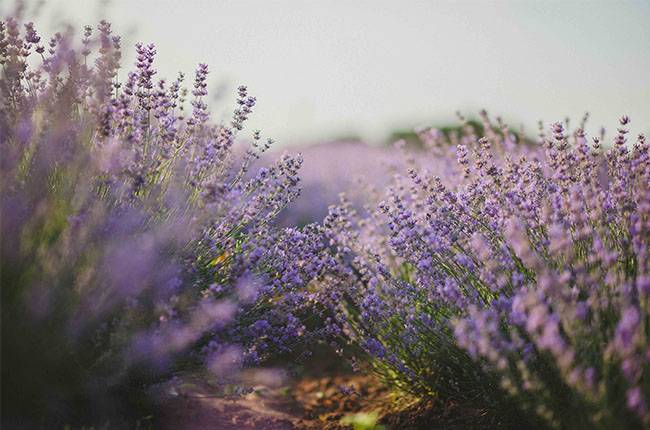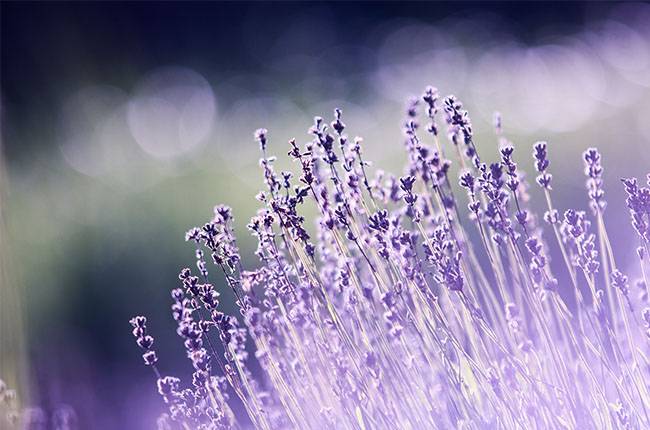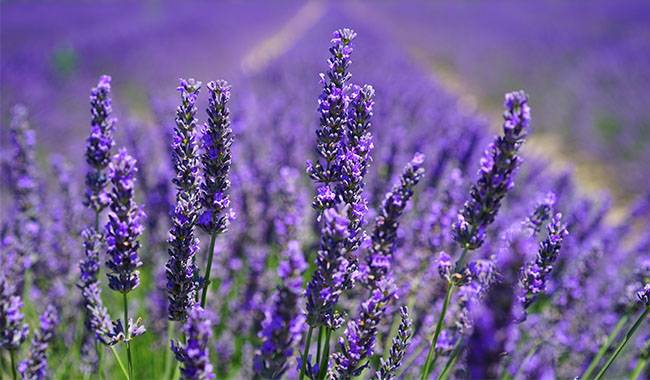
Lavender (Latin scientific name: Lavandula angustifolia Mill.) is also known as perfume plant, Ling vanilla, vanilla, yellow vanilla, Lavender.
A small shrub belonging to the genus Dicotyledon, Lamiaceae, and Lavender. The stem is erect, covered with stellate hairs, old branches gray-brown, with the striped peeling cortex.
The leaves are striped or lanceolate strips, with sparse or dense gray star-like hairs, grayish-white or olive green when dry, and curled all over.
Ring cymes gather into discontinuous or nearly continuous spikes at the top of branches; bracts are diamond-ovate, bracteoles are inconspicuous; calyxes are ovate-cylindrical or nearly cylindrical;
The corolla is about twice as long as Cao, the tube is straight and it is covered with glandular hairs in the throat. The nutlets are oval and smooth.
It is native to the Mediterranean coast, all over Europe and the Oceania archipelago, and was later widely planted in Britain and Yugoslavia.
Its leaf-shaped flowers are graceful and elegant, and the blue-purple inflorescence is long and beautiful. It is a new perennial cold-resistant flower in the courtyard. It is suitable for planting in clusters or strips, and can also be potted for viewing.
Characteristics of lavender
Lavender is a semi-shrub or dwarf shrub, branched, covered with stellate hairs, denser in the young part;
Old branches are grayish-brown or dark brown, with strips peeling off the cortex, with long flowering branches and short regeneration branches.
The leaves are linear or lanceolate, the leaves on the flowering branches are larger, sparse, 3-5 cm long, 0.3-0.5 cm wide, densely or sparsely gray stellate villi, grayish-white or olive green when dry, renewing The leaves on the branches are small, clustered, no more than 1.7 cm long, 0.2 cm wide, densely covered with off-white stellate villi, off-white when dry, all obtuse at the apex, the base gradually narrows into a very short stalk, the entire margin, the margin is revolved, and the midrib Uplift below, side veins and network veins are not obvious.
Cymes usually have 6-10 flowers, most of which are clustered into intermittent or nearly continuous spikes at the top of the branches. The spikes are about 3-5 cm long, and the peduncle is about 3 times the length of the inflorescence itself, densely covered with stellate Fluff
The bracts are rhomboid-ovate, the apex is acuminate into diamond-shaped, with 5-7 veins, the stem is often rusty, with stellate hairs, bracteoles inconspicuous;
Flowers short-stalked, blue, densely gray, branched or unbranched tomentose. The calyx is ovate-tubular or subtubular, 4-5 mm long, with 13 veins, the inner surface is nearly glabrous, two-lipped, the upper lip has 1 tooth wider and longer, and the lower lip has 4 short teeth. The teeth are equal and obvious.
The corolla is about twice as long as the calyx, with 13 veins. The outer surface is covered with the same hairy coat as the calyx, but the base is almost glabrous. The inner surface is covered with glandular hairs at the throat and crown, and the middle part has hair rings. Lip-shaped, the upper lip is straight, 2-lobed, the lobes are larger, round, and slightly overlap each other, the lower lip is spread out, 3-lobed, and the lobes are smaller. Stamens 4, inserted above the hair ring, not extended, long anterior pair, flat filaments, glabrous, and anthers covered with hair. Style is hairy, flattened at the apex, ovoid. Disc 4 lobed, lobes opposite to ovary lobes.
Nutlets 4, oval, smooth, shiny, with a base surface. Flowering in June.
The whole plant has a light aroma with a slightly woody sweetness. Because the villi on the flowers, leaves, and stems have oil glands, the oil glands will burst and release the fragrance when lightly touched.
The origin of lavender
Lavender is wild in the southern foothills of the Alps along the Mediterranean coast of France and southern Italy, as well as in Spain and North Africa.
In the 13th century, it was the main planting plant in the gardens of European medical monasteries; in the 15th century, it was planted in the Helvetia region;
At the end of the 16th century, cultivation began in southern France; in the 18th century, Secret in Surrey, Lavender Hill in South London, Provence in France, and the mountains near Grasse were all famous for planting lavender and became world-famous tourist attractions.
In the 19th century, Britain, Australia, the United States, Hungary, Bulgaria, Russia, Japan, and other countries successively introduced and cultivated them, and they have now spread throughout the Mediterranean and Black Sea coastal countries.
Growth habits of lavender
Temperature
Lavender is highly adaptable. Adult plants are resistant to both low temperature and high temperature and can withstand high temperatures of about 40°C during the harvest season. In some northern regions, it can withstand low temperatures of -37°C after being buried in soil and covered with snow. The seedlings can tolerate low temperatures of -10°C.
During the growth and development of lavender in the next year, the average temperature is around 8℃, and it takes 10-15 days to start sprouting;
The average temperature is 12~15℃, and it takes 20 days for the branches of the plants to start turning green and elongating; the average temperature is 16~18℃, and it takes 25~30 days for budding to begin; the average temperature is 20~22℃, and flowering begins; ℃, is the fruiting period.
Moisture
Lavender is a kind of plant that prefers dry and does not need much water. The annual rainfall is more suitable for 600~800mm. During the re-greening period and budding period, the plants grow faster and require a lot of water; the flowering period requires less water, and the water supply during the fruiting period should be appropriate;
During winter dormancy, winter irrigation or snow cover is required.
Therefore, the ideal rainfall distribution in a year is abundant in spring, a moderate amount in summer, and sufficient snow in winter.
Sunshine
Lavender is a long-day plant. It requires sufficient sunshine during its growth and development period and requires more than 2000 hours of sunshine throughout the year. If the plant is in a humid environment, it will grow stunted and age quickly.
Soil
Lavender has a well-developed root system, a fertile soil with a deep, loose, well-ventilated, and rich silicon-calcium layer. Strongly acidic or alkaline soils and plots with heavy stickiness, poor drainage, or high groundwater levels are not suitable for planting.
Lavender reproduction method
Sexual reproduction
Sowing and raising seedlings have fast reproduction, a well-developed root system, and strong seedlings, but with large variability, it is a good material for selection. Seeds should be of uniform size, full kernels, and brownish luster.
Before sowing, soak the seeds in warm water at 30°C for 12-24 hours, soak the seeds in concentrated sulfuric acid for 5 minutes, wash them with water and dry them before sowing.
Seeds can be used for sowing propagation in April. The minimum temperature for seed germination is 8-12°C, and the optimum temperature is 20-25°C. Planting is carried out in May. However, lavender seeds have a large variation in seed propagation and higher seed prices.
Asexual reproduction
Lavender is mainly reproduced by cuttings, which can maintain the excellent quality of the female parent. Cuttings are highly adaptable and can be carried out in spring and autumn.
Generally, choose healthy plant top buds (approximately 5-10 cm) without diseases and insect pests or cuttings that are tender and not lignified. When cutting, remove the leaves of the bottom 2 nodes, and then use some rooting agent to mix with water at a ratio of 100:1 Soak in the liquid, and after treatment, it will take about 2 to 3 weeks after being cut into the soil.
After skewing, place the seedlings in a ventilated and cool environment. Keep the soil moist for the first 3 days. Later, depending on the weather, ensure that the branches do not wrinkle or dry out and increase the survival rate.
The management of cutting seedlings is more convenient, no fertilization is required throughout the seedling period, and more production is used.
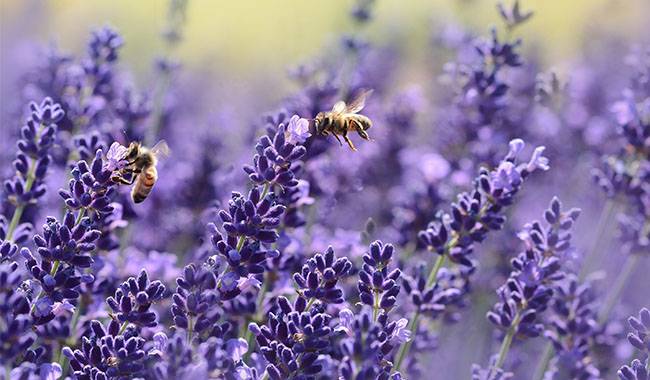
The main value of lavender
Medicinal value
Pharmacological activity
According to reports, it has been mainly used in the clinical and cosmetic industries in the form of dry products or essential oils in foreign countries for centuries.
The whole plant contains 1%~3% volatile oil. The use of lavender to treat diseases can be traced back to ancient Rome and ancient Greece.
Lavender essential oil is still as widely used as in the past few centuries.
Lavender essential oil is a complex mixture of many different types of aromatic compounds, with more than 30 ingredients, the main ingredients are linalool, linalyl acetate, cineole, B-rokinene (including cis and trans) pairs, acetic acid Lavender esters, lavender alcohol, terpene-4-oil, camphor and so on.
Sedative and hypnotic effect
Lavender essential oil is mainly used in aromatherapy or massage. In 1993, Tullamore in Ireland used a mixture of volatile oils extracted from Luoqin, juniper, lavender, and sweet oregano to improve the sleep of the elderly in General Hospital.
In 1995, Graham also tried this, the purpose is to reduce the patient’s sleep disturbance, make it fall asleep quickly.
After 2 weeks of combined use with volatile oil atomization therapy, the number of patients who reported that they were sleeping well at night increased significantly, and the number of patients who needed a particularly quiet environment during night sleep decreased significantly.
Antispasmodic effect
In addition to its effects on the central nervous system, animal experiments have shown that lavender essential oil also has antispasmodic effects on the smooth muscle of the ileum and uterus.
Its antispasmodic effect does not act on adrenergic and cholinergic receptors, nor does it act on calcium channels, but acts by increasing the level of cyclic adenosine in the cell.
Lavender essential oil is also used in obstetrics. For example, adding it to bath water can reduce the pain and discomfort of mothers after childbirth.
Antibacterial effect
Lis-Balchin found that lavender essential oil has the activity against many kinds of bacteria,
Linalool is the main antibacterial component of lavender essential oil. It can inhibit the growth of 17 kinds of bacteria (including gram-positive and gram-negative bacteria) and 10 kinds of fungi.
It has been confirmed that both lavender essential oil and essential oil vapor have certain antifungal activity. 1% and 10% lavender extracts can inhibit the conidia germination and spore growth of Botrytis cinerea, and the inhibitory effect on spore growth is more effective than that on hyphae.
Lavender essential oil vapor can also inhibit the growth of dead bodies of Aspergillus fumigatus. The dosage required is equivalent to tea tree oil but higher than lemon-vanilla oil, cinnamon oil, and thyme oil.
The effective concentration of lavender essential oil against Trichophyton Mentagrophytes and T. rubrum is 10-20Lg/ml, and it can kill 60 kinds of conidia at a concentration of 150Lg/ml.
Neuroprotection
Lavender Angustifolia flower water extract dose-dependently inhibited the neurotoxicity induced by glutamate.
The extracts of 100Lg/ml and 1mg/ml obviously blocked the neurotoxicity of rat cerebellar granule cells cultured in vitro induced by glutamate, and the most effective dose was 1mg/ml.
Lipid-lowering effect
Some scholars cut human adipose tissue into small pieces, cultivated in 0.05% collagenase solution, and added the extract to the culture tube.
Fat degradation rate: (1.12+0.10) mg fat/cultivated tube with lavender extract, (2.37+0.18) mg fat/tube with lavender and fennel extract, control tube without extract (0.35+0.09) Mg fat/tube.
Treatment of cardiovascular insufficiency
Some people use several herbal extracts containing lavender for the treatment of cardiovascular insufficiency. The medicinal solution reduces headaches, dizziness, blood cholesterol index, and symptoms of low arterial pressure.
Treatment of neurosis
Li Shusheng et al. treated 50 patients with neuroses with lavender smelling fragrance, 8 weeks as a course of treatment, and found neurotic sleep disorders, mood disorders, somatization symptoms SCL-90 (symptom self-rating scale), STAI (state and personality anxiety) Self-check scale), EEG (electroencephalogram), REG (cerebral blood flow graph) all improved, and no adverse reactions were seen.
Edible value
Lavender tea is brewed from dried flower buds. Put one tablespoon into a pot and pour it into boiling water. You can enjoy it after simmering for 5 minutes. It is also delicious without honey and sugar. This tea has no side effects and has many benefits such as calming, relaxing gastrointestinal spasm, cooling and refreshing, eliminating flatulence, helping digestion, preventing nausea and dizziness, alleviating anxiety and neurological migraine, preventing colds, etc. It can also be consumed when hoarse is lost. It helps to recover, so it has the reputation of “the best partner for office workers”.
Health and Beauty
Because lavender has the effect of inhibiting bacteria, balancing oil secretion, and soothing the skin, it can also be used in cleansing products. Lavender extract is added to soap and cleanser products, and it is made after cold sterilization and preservation treatment and the application of its free advanced technology. High-end cleansing products such as lavender soap and facial cleanser.
Landscape value
There are many kinds of lavender plants, which have high ecological ornamental value. The plant is low, the whole plant is grayish-purple in all seasons, strong growth ability, pruning resistance, beautiful leaf shape, and color, noble and elegant.
It can be used to build a special aromatic botanical garden for lavender, which can integrate greening, beautification, coloring, and fragrance. It can not only watch, but also purify the air, cure diseases, and play a role in medical care.
The history and story of lavender
Source of name
In ancient Greece, lavender was called Nardus, and the name came from a city called Naarda in Syria.
One pound of lavender can be sold for one hundred denarii, which is approximately equal to a month’s salary of a farmworker at that time, or the salary of a barber for helping fifty people cut hair.
The Romans put lavender and various herbs in the bathwater together, and they introduced this bathing method to Britain.
Lavender is grown and sold all over the world. Lavender was always called “epic” in the 18th century, while in Provence, lavender was nicknamed “epi”. The word Lavender is derived from the Latin “Lavare”, which means to clean.
Ancient folklore lavender has always been a wonderful remedy for skin diseases.
Facts
In European tradition, lavender seems to be naturally related to love. A large number of love legends or folk customs involve lavender. “Lavender represents true love” is the most representative lyrical poem of the Elizabethan era.
The flower language of lavender is “waiting for love”. Just like the interpretation in the movie, lavender means a kind of implicit expression of love, a kind of firm promise, which can endure hardships and finally be able to hold the hand of the child.
Legend
Lavender is a fragrant purple-blue flower. It is as romantic as its location. This flower, born in Provence, France, has a beautiful love legend.
In Provence, France, which is one of the hometowns of lavender, there is such a love story about lavender…
There is a young girl in the village of Provence. She was alone in the cold mountains picking the budding flowers, but she met a wounded traveler from afar. When the girl saw this young man, her whole heart was lost. The personable smile was given to the prisoner!
So the girl invited him to the house, regardless of the family’s objections, insisted on taking care of him until he recovered. After a few days, the young traveler’s injuries had also recovered, but the relationship between the two has spread rapidly, and it has become inseparable. To the point of difficulty.
Someday not long after, the young traveler bid farewell to the girl and the girl in love insisted on leaving with the young man. Although her relatives tried hard to stay, she still insisted on going to the hometown full of roses with the young man!
Just before the girl left, the old lady in the village gave her a bunch of lavender and asked her to use the bunch of lavender to test the sincerity of young travelers.
The main reason: Legend has it that the scent of lavender can reveal unclean things. Just as the traveler took her hand to prepare for a long journey, the girl threw the lavender hidden in her coat on the young man. Unexpectedly, after a light purple smoke emitted from the young man’s body, it disappeared with the wind and smoke!
In the valley, the girl still seemed to hear the hearty laughter of the youth, and in this way, the girl was left alone.
It didn’t take long for the girl to disappear. Some people thought that she turned into a light smoke and disappeared into the valley like the youth. Others said that she followed the fragrance of lavender to find the youth…
In any case, the legend of lavender is passed down.
Therefore, lavender is still considered to be one of the important tools to get rid of unclean things and incense.
The benefits of lavender
Calming and tranquilizing effect
Lavender is recognized as the most calming, soothing, and hypnotic plant. It can relieve tension, calm the mind, and calm down the breath. There are many hospitals in the world that use the volatile oil extracted from lavender to improve the sleep of the elderly.
Antibacterial effect
Studies have found that lavender has obvious antibacterial effects. Linalool contained in lavender is the main component of lavender antibacterial. It can inhibit the growth of 17 kinds of bacteria (including gram-negative bacteria and gram-positive bacteria) and 10 kinds of fungi.
Anti-inflammatory and antioxidant effects
Apply lavender essential oil to the inflamed affected area, you can find that the healing speed of the affected area becomes faster, and it has a significant effect of reducing swelling.
At the same time, experiments have also proved that 50% methanol extract of Lavender Angustifolia can inhibit lipid peroxidation, and phenolic rosmarinic acid is an antioxidant active substance.
Antispasmodic and analgesic effects
Lavender also has an antispasmodic effect on the smooth muscle of the ileum and uterus. Its antispasmodic effect is not through adrenaline and cholinergic receptors, nor does it act on calcium channels, but by increasing the level of intracellular adenosine cyclophosphamide.
Lipid-lowering and blood pressure-lowering effects
Studies have found that lavender extract has a clear fat-reducing effect. At the same time, the lavender essential oil can also reduce the average level of arterial pressure through smell.
Protect the liver
Lavender has a definite hepatoprotective effect. Some scholars conducted an experiment using carbon tetrachloride to make a mouse model of acute chemical liver injury. The alcohol extract of lavender was given to mice by gavage. Injury, lavender can play a very good protective effect.
Resist depression
Lavender essential oil is also a good anti-depression essential oil. Therefore, women with various emotional problems caused by hormonal imbalance, such as premenstrual tension, menopausal depression, postpartum depression, etc., can also be directly inhaled or massaged To improve symptoms.
Inhibit tumors
In various studies on lavender, it has been found that lavender can inhibit tumors, especially for the growth of human liver cancer cells and lung cancer cells. The inhibitory effect is relatively obvious.
Regulate physical fitness
When the body suffers from certain pollution or the body becomes acidic, the most obvious symptoms are emotional tension and restlessness.
For example, a beauty who desperately eats snacks in the evening and slack off at the weekend is an eating disorder caused by emotional stress. Lavender has a strong flavor and can calm nerves, relieve pain and calm, and relieve insomnia, headaches, and restlessness.
Repellent effect
Lavender can eliminate ants, cockroaches, and mites. When it is placed under a wardrobe or pillow, it can not only replace mothballs but also leave a refreshing fragrance.




